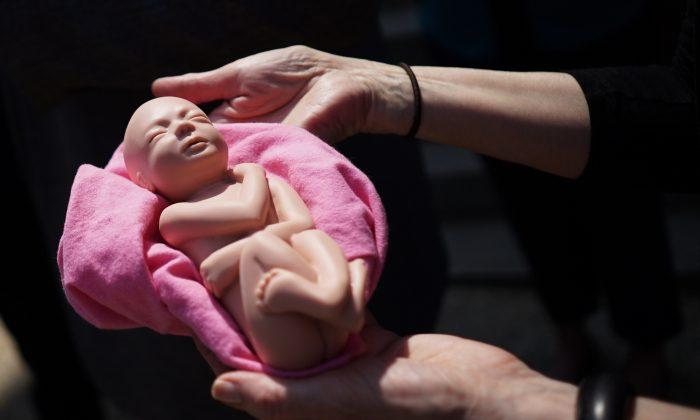Commentary
For several decades, the incidence of childhood autism has been growing at an alarming rate in North America, and elsewhere around the world. Autism is a hugely expensive mental malady that also causes much stress within families and has led in some cases to parents divorcing.
Can anything be done to reduce the risk of childhood autism? It has already been
established that babies born prematurely (under 37 weeks’ gestation), are at a much higher—7 percent—risk of autism than babies born after a full-term delivery (under 2 percent). Numerous studies have also established that women who undergo induced abortions have a much higher subsequent risk of giving birth prematurely. Within the past few years, there have been more and more studies indicating that women who have abortions have a much higher risk of subsequently bearing a child with autism.
Yet there has been virtually no public discussion of these findings.
The global incidence of autism is now around
one in 160 children. In North America, the rise has been much more dramatic. The Centers for Disease Control and Prevention in Atlanta reports that the prevalence of Autism Spectrum Disorder (ASD) has reached nearly 2 percent, or
one child in 54. Poland stands out as a major exception to this alarming phenomenon, for reasons that we’ll discuss below.
A variety of risk factors for autism have been identified. Maternal age is one—the older the mother, the higher the chance that her baby will be born with autism. Sex is also a risk factor. Boys are four to five times more likely to be born with autism than girls. Being born prematurely, or with a low birth weight, is also connected with an increased risk of later development of autism.
Yet there’s one major factor that’s never discussed outside the pages of specialized medical journals. That factor is induced abortion.
We have counted no fewer than eight studies over the past 22 years in respected medical journals—several of them from China—all pointing to abortion as a major risk factor for autism.
As early as 1999, an international group of researchers reported in the
Journal of Perinatal Medicine that a woman who terminates one or more pregnancies through induced abortion, miscarriage, or stillbirth, has almost double the risk of delivering a baby later diagnosed with autism. Three years later, a paper in the
International Journal of Neuroscience revealed that abortions were “significantly more common” among women who bore autistic children than among women who did not. In fact, abortions were among the three most significant factors linked to autism.
A few years later, another major study in the respected journal
Pediatrics found that a quarter of children born prematurely screened positively for autism. A few years after that,
another study confirmed premature birth as “an established risk factor” for autism. Now it has been well-known for some time that induced abortion results in a significantly higher rate of premature births in a woman’s later pregnancies.
Therefore, the conclusion is unavoidable: Abortion is a significant factor in the recent alarming increase in the incidence of autism. It’s no surprise that almost all of this increased risk has taken place since the legalization of abortion in many countries from the 1960s onward.
In the past few years, there have been a growing number of studies directly linking induced abortion with the rising global incidence of autism spectrum disorders (ASD). The evidence continues to pile up. For example,
one large study found that a higher percentage of mothers of children with ASD reported previous abortions than mothers with no ASD children. The study of American nurses reported, after adjusting for other factors, that those who had had previous abortions experienced a 26 percent increased risk of bearing a child with ASD. This finding is all the more impressive because these women all boasted “a high level of health education and good access to health care, [and a] detailed and prospectively collected obstetric history.”
To all the studies directly linking abortion with autism may be added those that make passing reference to prior abortions as being “significantly more common” among women who bore autistic children than women who did not.
When we turn to China, the findings are similar, but much more striking.
For example,
one Chinese study found that mothers with a history of abortion suffered 12 times the risk of bearing a child with autism.
Another recent Chinese study (
pdf) found that abortion was one of the five main factors associated with autism. To be more precise, a mother who had a previous abortion had more than twice the risk of bearing a child with ASD. (The exact figure was 2.07 times the risk.) The same study also put the finger on premature birth as a significant risk factor for autism. As we have seen, women who have abortions are much more likely to give birth prematurely in a later pregnancy.
Another recent
study from China tells us that the “mother’s induced abortion history” is one of the main influencing factors for ASD.
Corroboration of these findings from China comes from a recent
Vietnamese study revealing that in Hoa Binh Province, women with previous abortions have a 274 percent greater risk of bearing a child with autism. This appeared in the prestigious Journal of Health Developmental Studies in 2019.
Another interesting piece of corroborating evidence comes from Poland. In 1989, shortly after the fall of communism and the election of a democratic government, that country passed a law banning virtually all abortions. The law worked: Apart from a small percentage of women who go to Russia or Hungary to obtain abortions, the practice of induced abortion has largely disappeared from Poland.
Over 30 years later, Poland now boasts just about the lowest autism rate in the world—
one child in every 2,900. Compare this to one child in 54 in the United States and
one child in 66 in Canada. No one is claiming (yet) that Poland’s low rate of abortion has directly contributed to the very low rate of autism, but the association between the two is remarkable.
So, to sum up, all the studies that have examined induced abortion as a significant factor in a mother’s subsequent delivery of a child with ASD have uncovered a positive link. We’ve not found a single study that denies the link. In good scientific fashion, there will need to be quite a few more studies establishing such a link before anyone can talk about induced abortion being a “cause” of autism. But in the meantime, the evidence is growing.
The purpose of this article is to raise the question: Why is there no discussion in the mainstream media of all this evidence? It’s certainly no service to women to hide these findings, any more than it’s a service to women to hide the clearly established findings of a definite link between abortion and breast cancer, or between abortion and premature births, or between the contraceptive pill and breast cancer. Yet few doctors or midwives inform women hoping to become pregnant of these risks. Neither do abortion consent forms warn of the undeniable risk of premature delivery. And yet, failure to warn patients about the credible adverse risks of a medical treatment violates both Canadian and U.S. law.
The first columnist in a major newspaper to link abortions with autism was
Barbara Kay in Canada’s National Post in January 2012. Almost a decade later, isn’t it high time that the rest of the mainstream media let people know what has since been established about this risk?
Views expressed in this article are opinions of the author and do not necessarily reflect the views of The Epoch Times.






